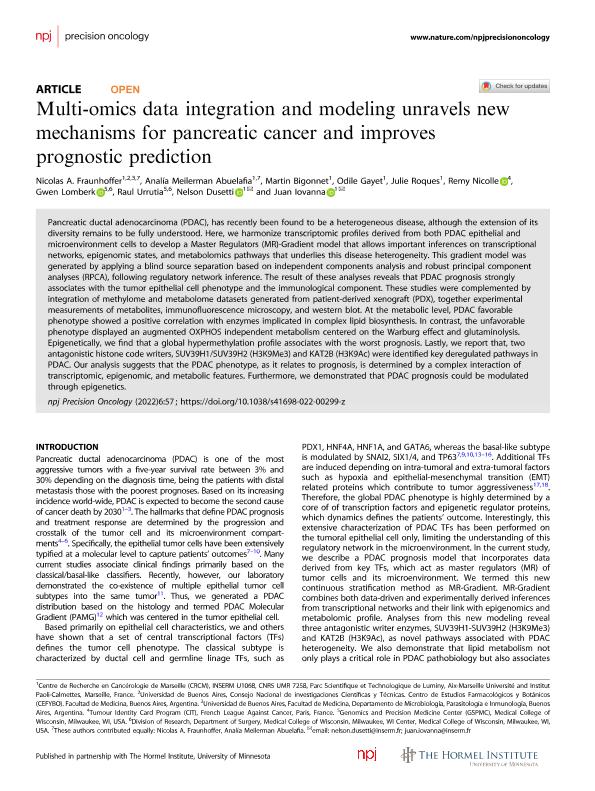Artículo
Multi-omics data integration and modeling unravels new mechanisms for pancreatic cancer and improves prognostic prediction
Fraunhoffer Navarro, Nicolas Alejandro ; Abuelafia, Analía Meilerman; Bigonnet, Martin; Gayet, Odile; Roques, Julie; Nicolle, Remy; Lomberk, Gwen; Urrutia, Raul; Dusetti, Nelson; Iovanna, Juan Lucio
; Abuelafia, Analía Meilerman; Bigonnet, Martin; Gayet, Odile; Roques, Julie; Nicolle, Remy; Lomberk, Gwen; Urrutia, Raul; Dusetti, Nelson; Iovanna, Juan Lucio
 ; Abuelafia, Analía Meilerman; Bigonnet, Martin; Gayet, Odile; Roques, Julie; Nicolle, Remy; Lomberk, Gwen; Urrutia, Raul; Dusetti, Nelson; Iovanna, Juan Lucio
; Abuelafia, Analía Meilerman; Bigonnet, Martin; Gayet, Odile; Roques, Julie; Nicolle, Remy; Lomberk, Gwen; Urrutia, Raul; Dusetti, Nelson; Iovanna, Juan Lucio
Fecha de publicación:
12/2022
Editorial:
Nature Publishing Group
Revista:
npj Precision Oncology
e-ISSN:
2397-768X
Idioma:
Inglés
Tipo de recurso:
Artículo publicado
Clasificación temática:
Resumen
Pancreatic ductal adenocarcinoma (PDAC), has recently been found to be a heterogeneous disease, although the extension of its diversity remains to be fully understood. Here, we harmonize transcriptomic profiles derived from both PDAC epithelial and microenvironment cells to develop a Master Regulators (MR)-Gradient model that allows important inferences on transcriptional networks, epigenomic states, and metabolomics pathways that underlies this disease heterogeneity. This gradient model was generated by applying a blind source separation based on independent components analysis and robust principal component analyses (RPCA), following regulatory network inference. The result of these analyses reveals that PDAC prognosis strongly associates with the tumor epithelial cell phenotype and the immunological component. These studies were complemented by integration of methylome and metabolome datasets generated from patient-derived xenograft (PDX), together experimental measurements of metabolites, immunofluorescence microscopy, and western blot. At the metabolic level, PDAC favorable phenotype showed a positive correlation with enzymes implicated in complex lipid biosynthesis. In contrast, the unfavorable phenotype displayed an augmented OXPHOS independent metabolism centered on the Warburg effect and glutaminolysis. Epigenetically, we find that a global hypermethylation profile associates with the worst prognosis. Lastly, we report that, two antagonistic histone code writers, SUV39H1/SUV39H2 (H3K9Me3) and KAT2B (H3K9Ac) were identified key deregulated pathways in PDAC. Our analysis suggests that the PDAC phenotype, as it relates to prognosis, is determined by a complex interaction of transcriptomic, epigenomic, and metabolic features. Furthermore, we demonstrated that PDAC prognosis could be modulated through epigenetics.
Palabras clave:
PDAC
,
MULTIOMICS
,
GRADIENTS
Archivos asociados
Licencia
Identificadores
Colecciones
Articulos(CEFYBO)
Articulos de CENTRO DE ESTUDIOS FARMACOLOGICOS Y BOTANICOS
Articulos de CENTRO DE ESTUDIOS FARMACOLOGICOS Y BOTANICOS
Citación
Fraunhoffer Navarro, Nicolas Alejandro; Abuelafia, Analía Meilerman; Bigonnet, Martin; Gayet, Odile; Roques, Julie; et al.; Multi-omics data integration and modeling unravels new mechanisms for pancreatic cancer and improves prognostic prediction; Nature Publishing Group; npj Precision Oncology; 6; 1; 12-2022; 1-16
Compartir
Altmétricas



